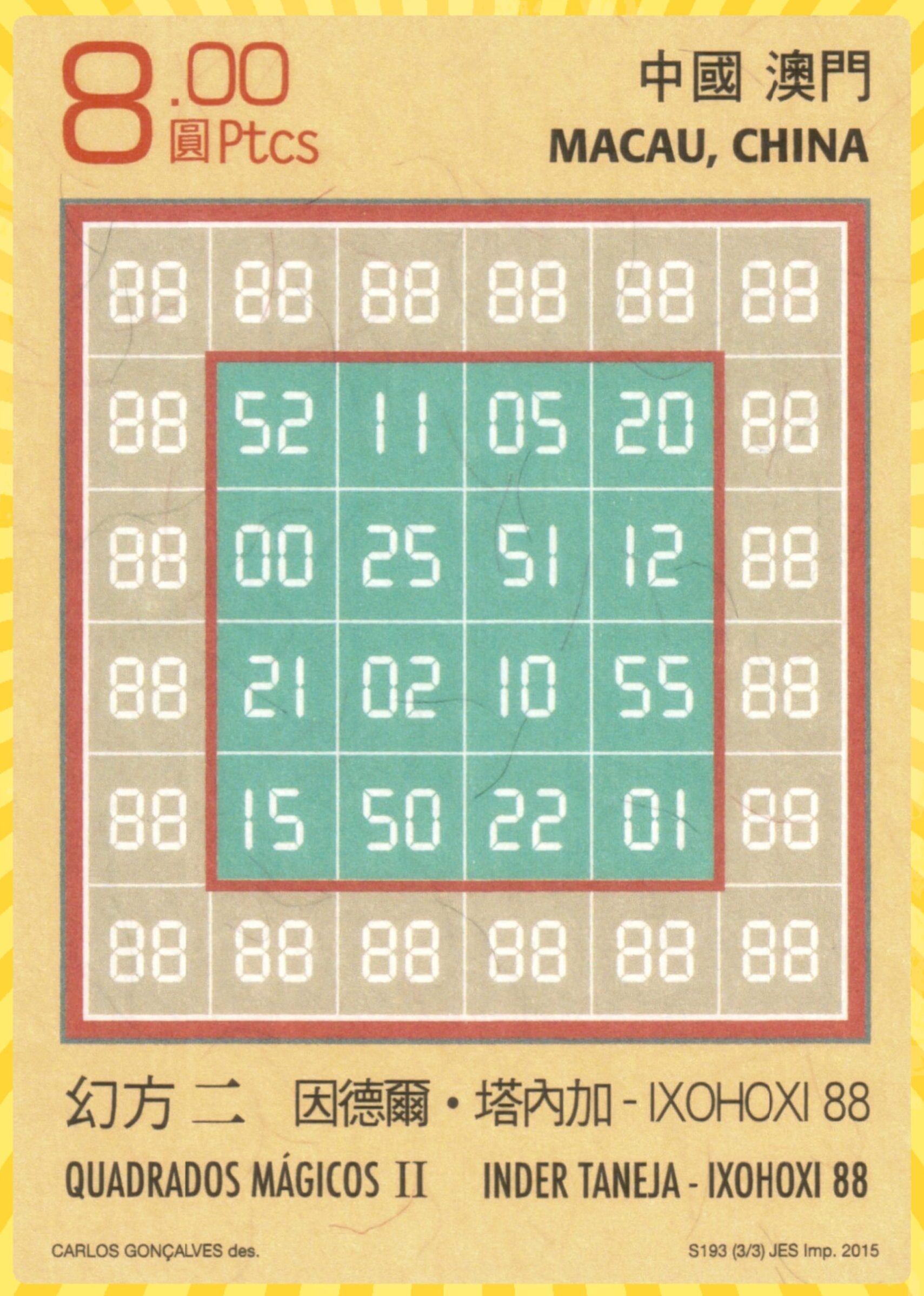There are many ways of representing magic squares with palindromic type entries. Also, we can write magic squares in the composite forms based on pair of Latin squares. This paper works with magic squares of order 11 to 15. By upside-down, we understand than by making 180o it remains same. When the magic square is of both type, i.e., upside-down and mirror looking, we call it an universal magic square. By mirror looking we understand that putting in front of mirror, still we see the image as a magic square. In case of mirror looking, writing as digitais fonts, 2 becoms 5 and 5 as 2. In case of upside-down, 6 becomes 9 and 9 as 6.
For complete work for the orders 3 to 25, see the reference list at end of this work. For this work, see the online link given below:
- Inder J. Taneja, Universal and Upside-Down Magic Squares of Orders 11 to 15, Zenodo, November 05, 2024, pp. 1-141, https://doi.org/10.5281/zenodo.14041168
Magic Squares of Order 11
a) 4-Digits Cell Entries
Example 1: The Digits (1,6,9)
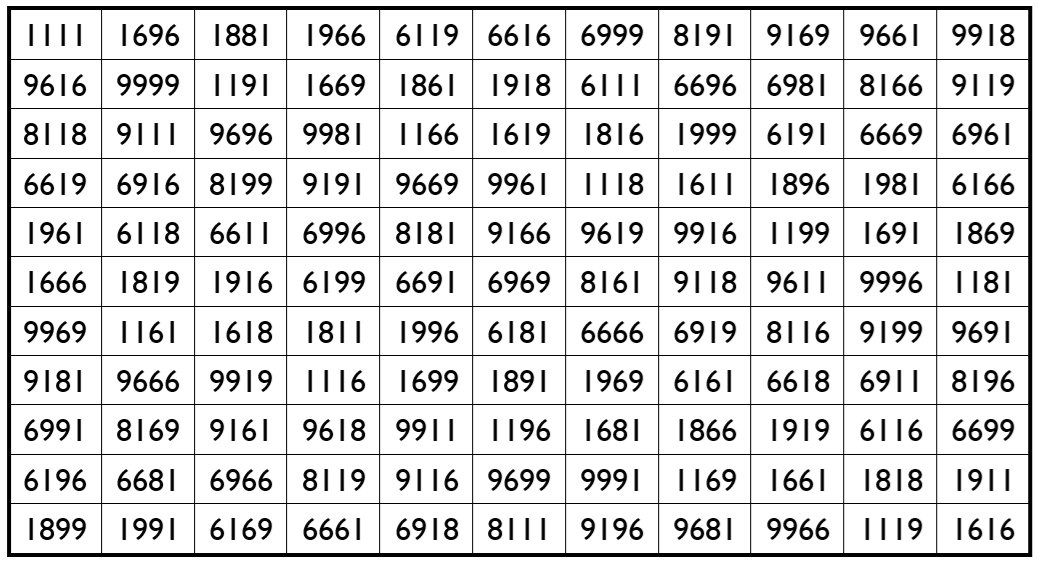
It is pandiagonal upside-down magic square with magic sum S11×11(1,6,8,9):=63327.
Example 2. The Digits (0,2,5,8)
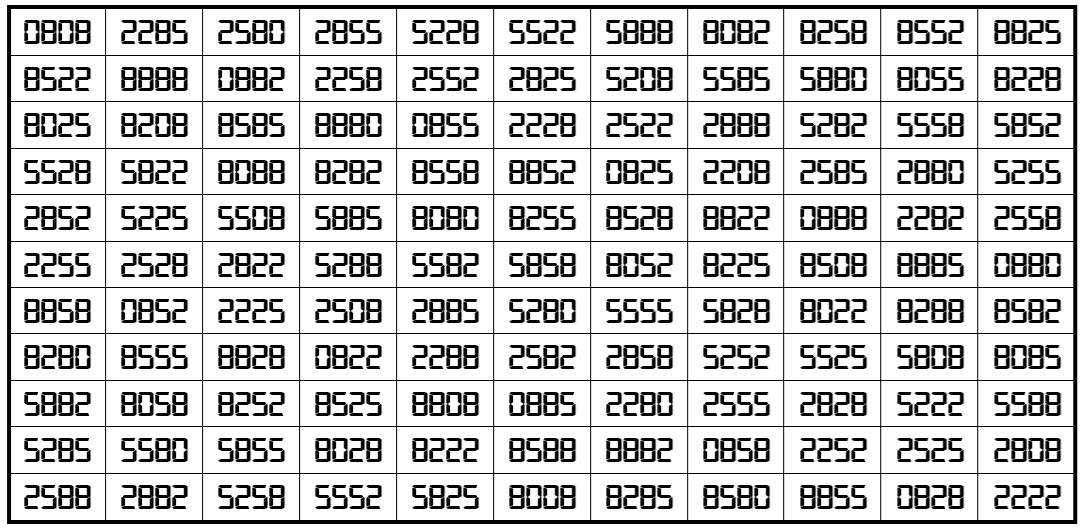
It is pandiagonal universal magic square of order 11. Its magic sum is S7×7(0,2,5,8):=58883.
b) 6-Digits Cell Entries
Example 3. The Digits (1,6,9)
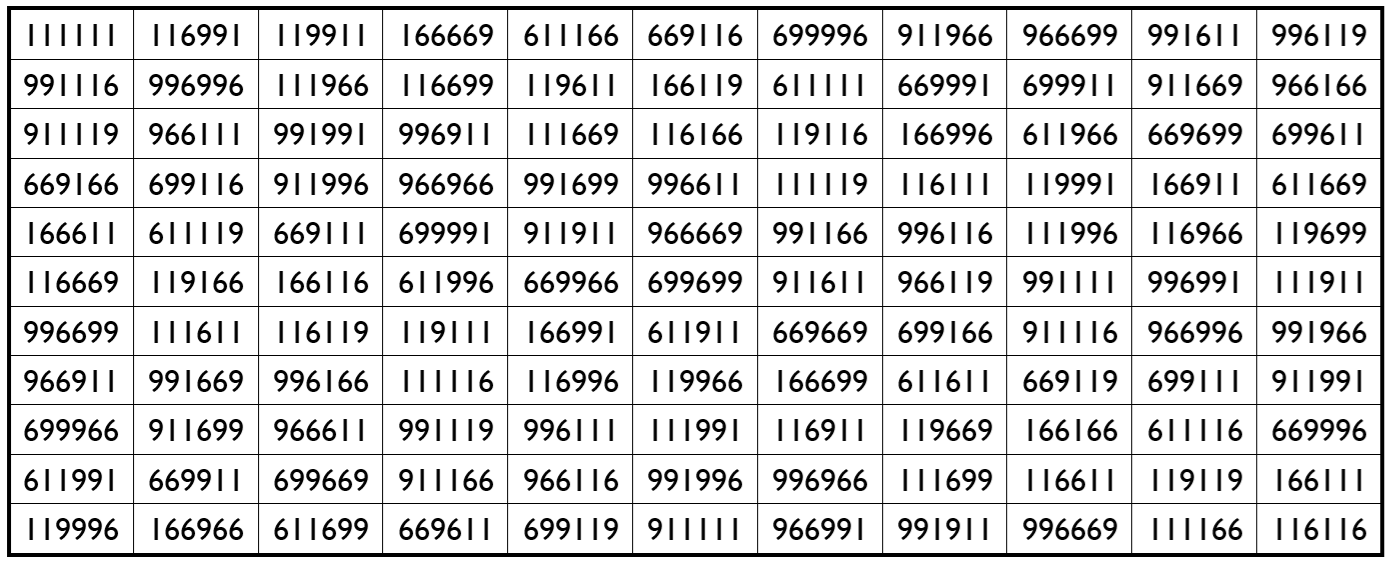
It is pandiagonal upside-down magic square with magic sum S7×7(1,6,9):=6361355.
Example 4. The Digits (2,5,8)
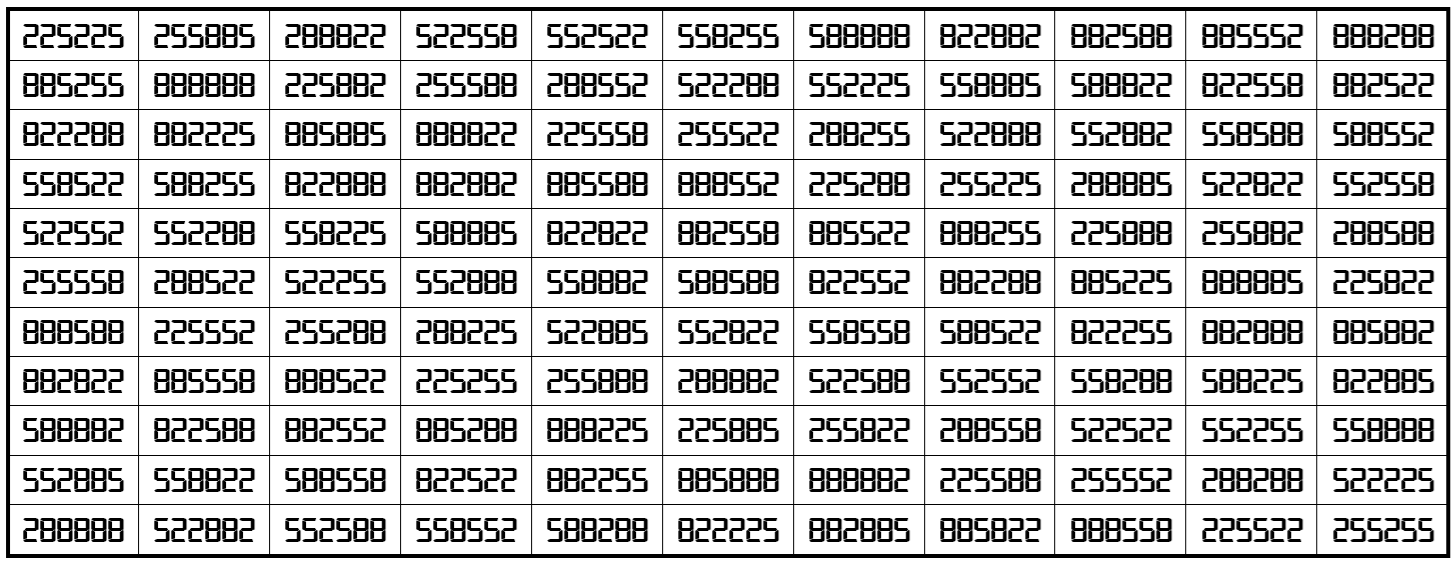
It is pandiagonal universal magic square. In this case the magic sums are different, i.e., the magic sums of original and mirror looking are the same, but in upside-down situation the sum is different. The sums are as follows:
SO11×11(2,5,8):=SM11×11(2,5,8):=6471465 and SO11×11(2,5,8):=6174168.
c) 8-Digits Cell Entries
Example 5. The Digits (1,8)

It is universal pandiagonal magic square of order 11 for the digits (1,8). Its magic sum is S11×11(1,8):=511111106.
Example 6. The Digits (2,5)
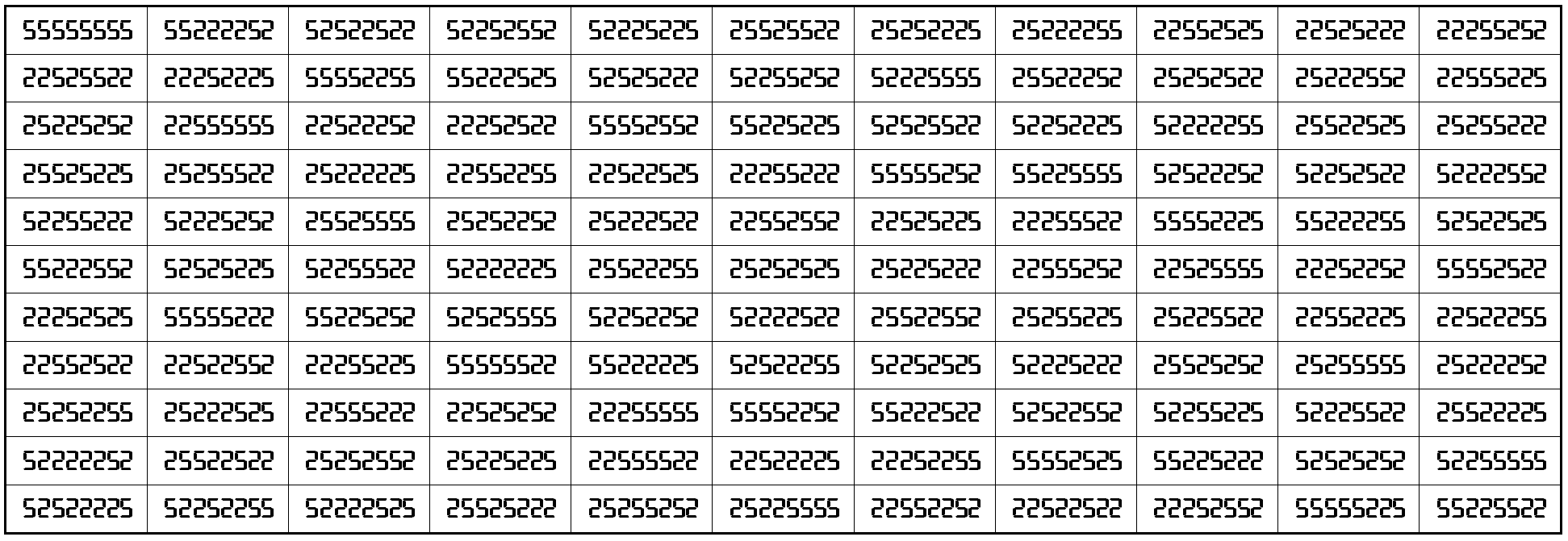
It is universal pandiagonal magic square of order 11 for the digits (2,5). Its magic sums are S11×11(2,5):=411111107 and S11×11(2,5):=444444440. The S11×11(2,5):=444444440 refers to mirror-looking verion of magic square.
Example 7. The Digits (6,9)

It is upside-down pandiagonal magic square of order 11 for the digits (1,8). Its magic sum is S11×11(6,9):=905730564.
Magic Squares of Order 12
a) 4-Digits Cell Entries: Blocks of Order 4
Example 8. The Digits (1,6,8,9)
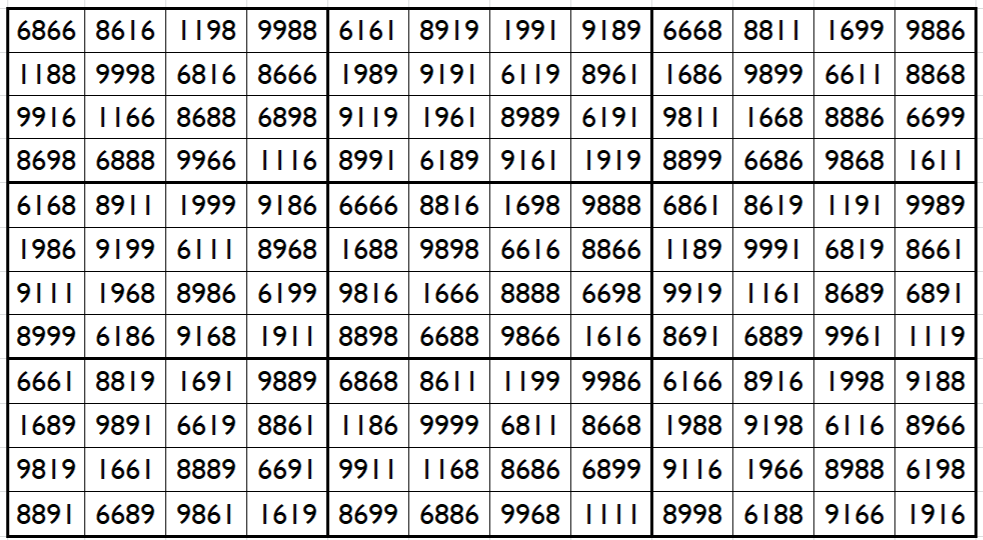
It is upside-down semi-magic square of order 12 in 4-digits (1,6,8,9) with magic sum S12×12(1,6,8,9) := 79992. Blocks of order 4 are magic squares with different magic sums.
Example 9. The Digits (1,2,5,8)
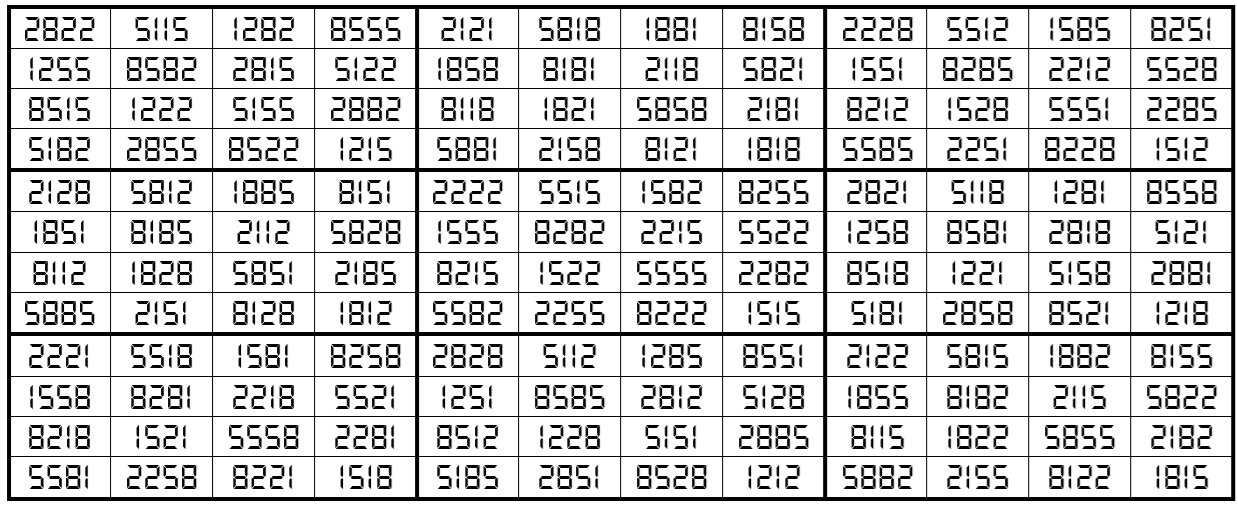
It is universal semi-magic square of order 12 in 4-digits (1,2,5,8) with magic sum S12×12(1,6,8,9):=53328. Blocks of order 4 are magic squares with different magic sums.
b) 6-Digits Cell Entries: Blocks of Order 4
Example 10. The Digits (1,6,9)
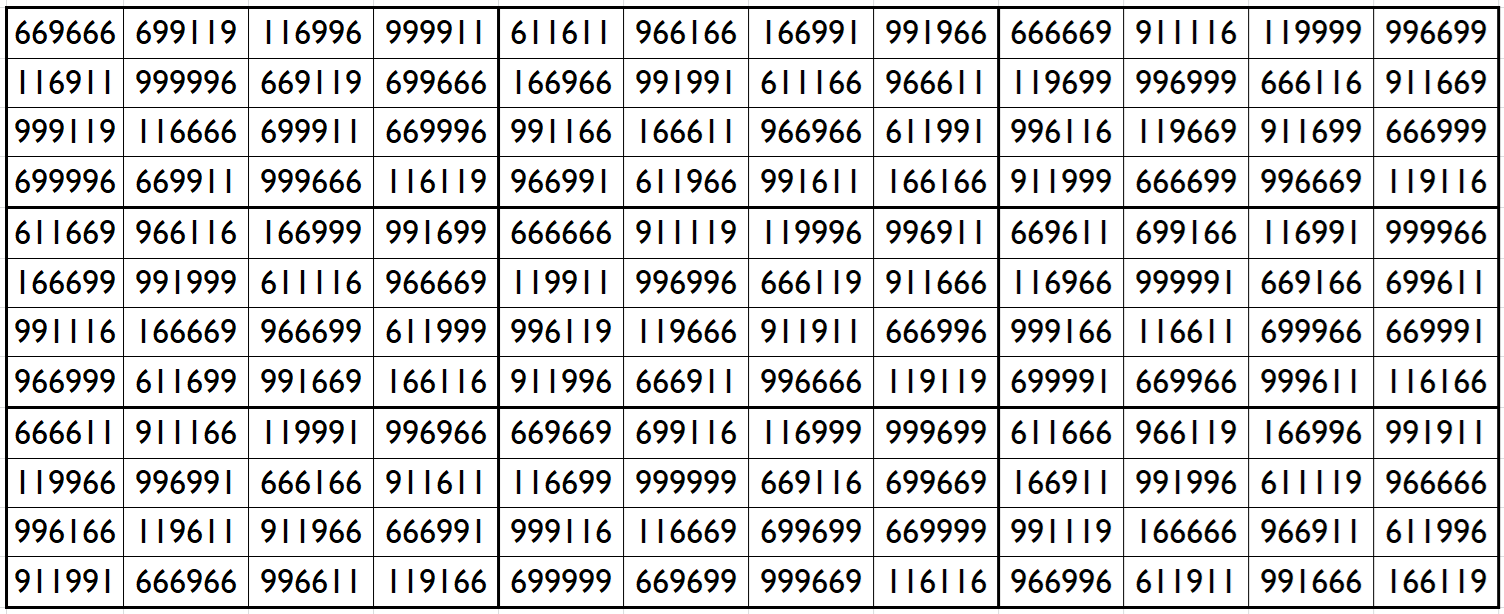
It is upside-down semi-magic square of order 12 in 3-digits (1,6,9) with magic sum S12×12(1,6,9) := 7916909. Blocks of order 4 are magic squares with different magic sums.
Example 11. The Digits (2,5,8)
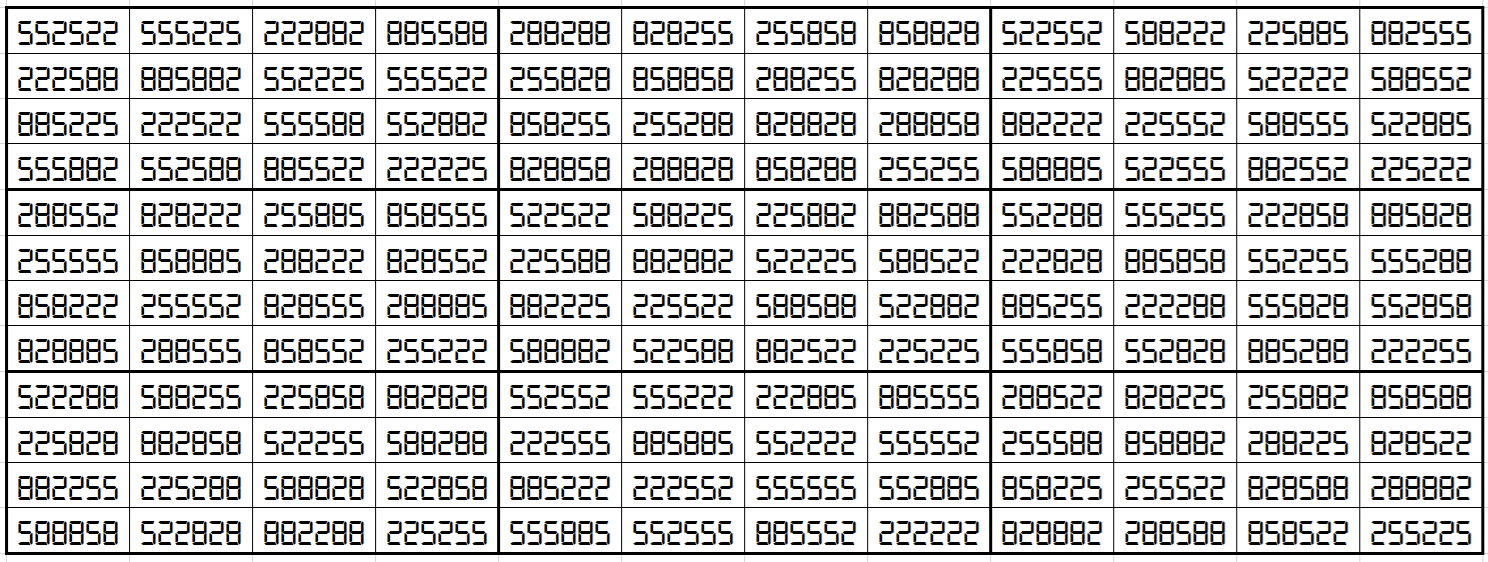
It is universal semi-magic square of order 12 in 3-digits (2,5,8) with magic sum S12×12(2,5,8):=6666660. Blocks of order 4 are magic squares with different magic sums.
c) 4-Digits Cell Entries: Blocks of Order 3
Example 12. The Digits (1,6,8,9)

It is upside-down semi-magic square of order 12 in 4-digits (1,6,8,9) with magic sum S12×12(1,6,8,9) := 87769. Blocks of order 3 are semi-magic squares with different semi-magic sums..
Example 13. The Digits (0,2,5,8)
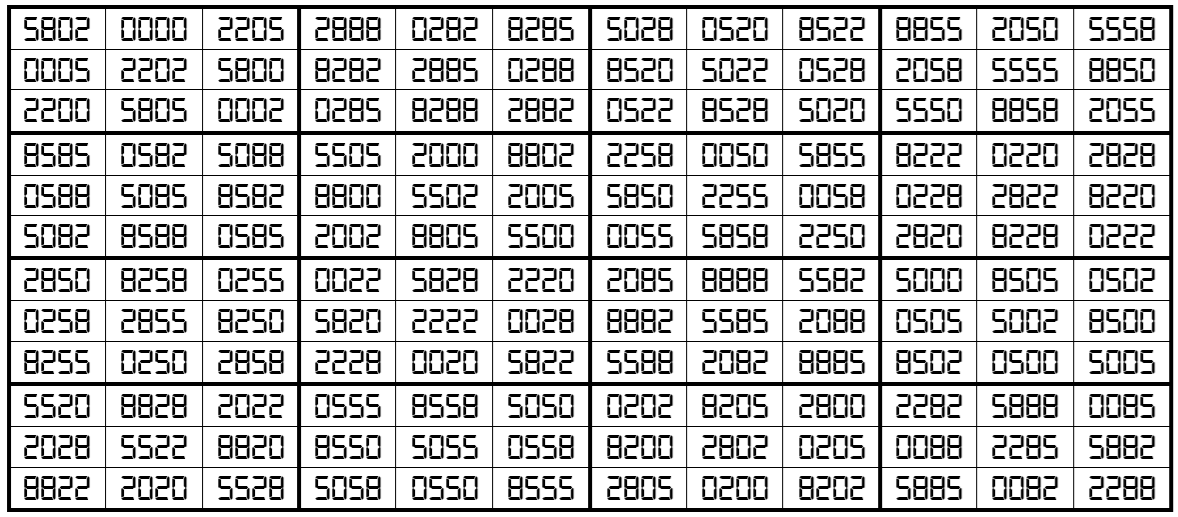
It is universal semi-magic square of order 12 in 4-digits (0,2,5,8) with magic sum S12×12(0,2,5,8):=49995. Blocks of order 3 are semi-magic squares with different semi-magic sums
d) 6-Digits Cell Entries: Blocks of Order 3
Example 14. The Digits (1,6,9)

It is upside-down semi-magic square of order 12 in 3-digits (1,6,9) with magic sum S12×12(1,6,9) := 7916909. Blocks of order 3 are semi-magic squares with different semi-magic sums.
Example 15. The Digits (2,5,8)
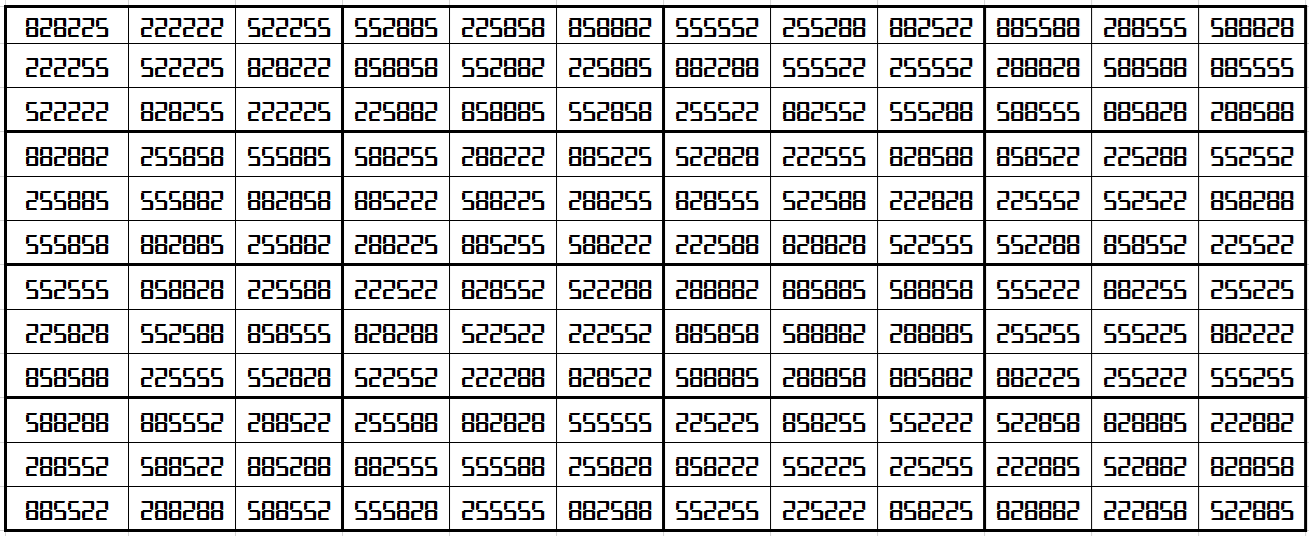
It is universal semi-magic square of order 12 in 3-digits (2,5,8) with magic sum S12×12(0,2,5,8):=6666660. Blocks of order 3 are semi-magic squares with different semi-magic sums
d) 8-Digits Cell Entries: Blocks of Order 3
Example 16. The Digits (1,8): The Blocks of Order 4

It is universal pandiagonal magic square with magic sum: S12×12(1,8):=599999994. Block of order 4 are pandiagonal magic square with equal magic sums: S4×4(1,8):=199999998.
Example 17. The Digits (1,8): The Blocks of Order 6
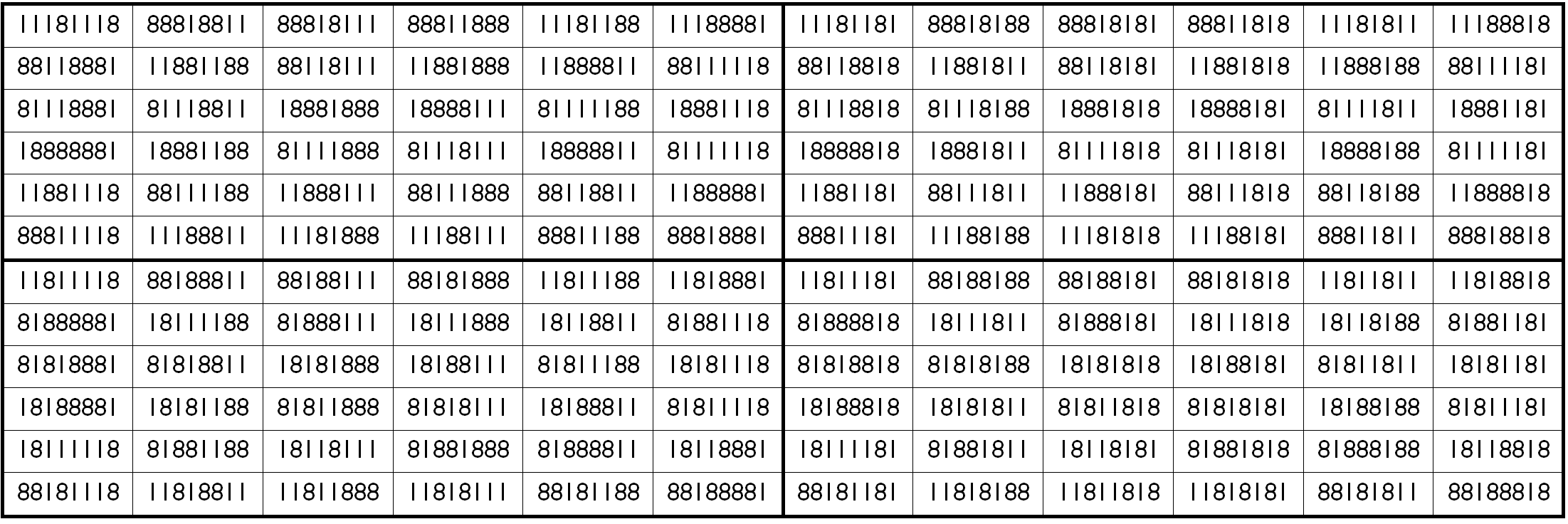
It is universal magic square with magic sum: S12×12(1,8):=599999994. Blocks of order 6 are magic square with equal magic sums: S6×6(1,8):=299999997.
Example 18. The Digits (1,8): The Blocks of Order 3
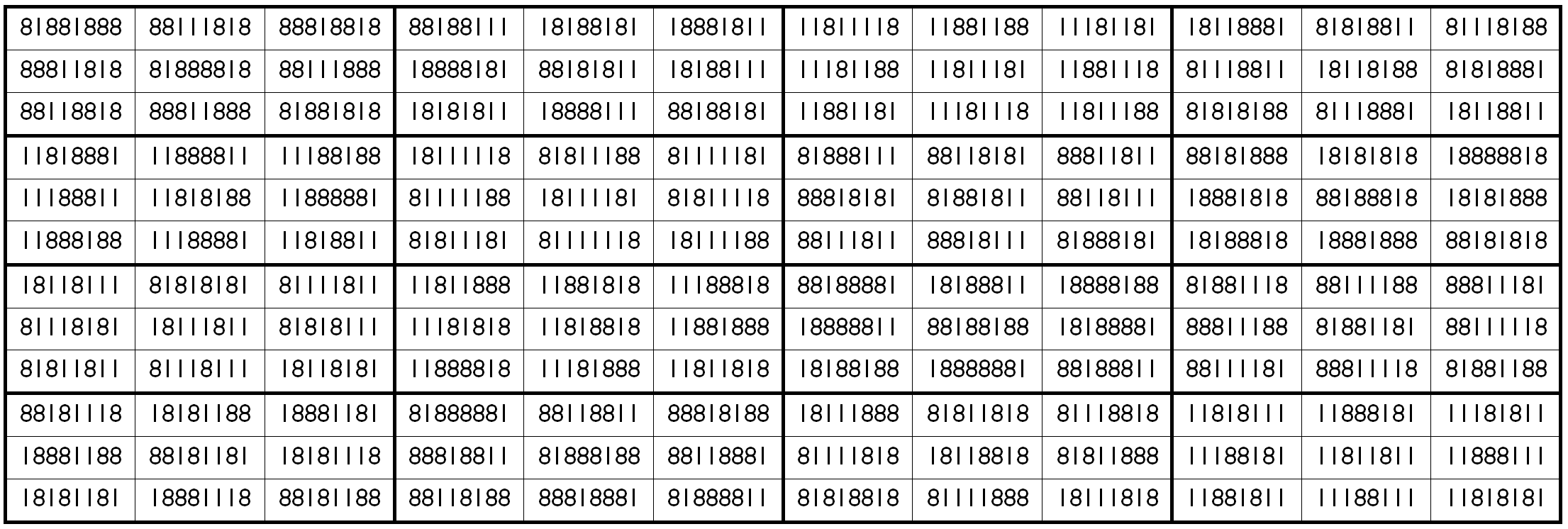
It is universal pandiagonal magic square with magic sum: S12×12(1,8):=599999994. Blocks of order 3 are semi-magic squares with different semi-magic sums.
Example 19. The Digits (2,5): The Blocks of Order 4

It is universal pandiagonal magic square with magic sum: S12×12(2,5):=466666662. The blocks of order 4 are pandiagonal magic square with equal magic sums, i.e., S4×4(2,5):=155555554.
Example 20. The Digits (2,5): The Blocks of Order 6

It is universal magic square with magic sum: S12×12(2,5):=466666662. Blocks of order 6 are magic square with equal magic sums: S6×6(2,5):=233333331.
Example 21. The Digits (2,5): The Blocks of Order 3

It is universal pandiagonal magic square with magic sum: S12×12(2,5):=466666662. Blocks of order 3 are semi-magic squares with different semi-magic sums.
Example 22. The Digits (6,9): The Blocks of Order 4

It is universal pandiagonal magic square with magic sum: S12×12(6,9):=999999990. The blocks of order 4 are pandiagonal magic square with equal magic sums, i.e., S4×4(6,9):=333333330.
Example 23. The Digits (6,9): The Blocks of Order 6
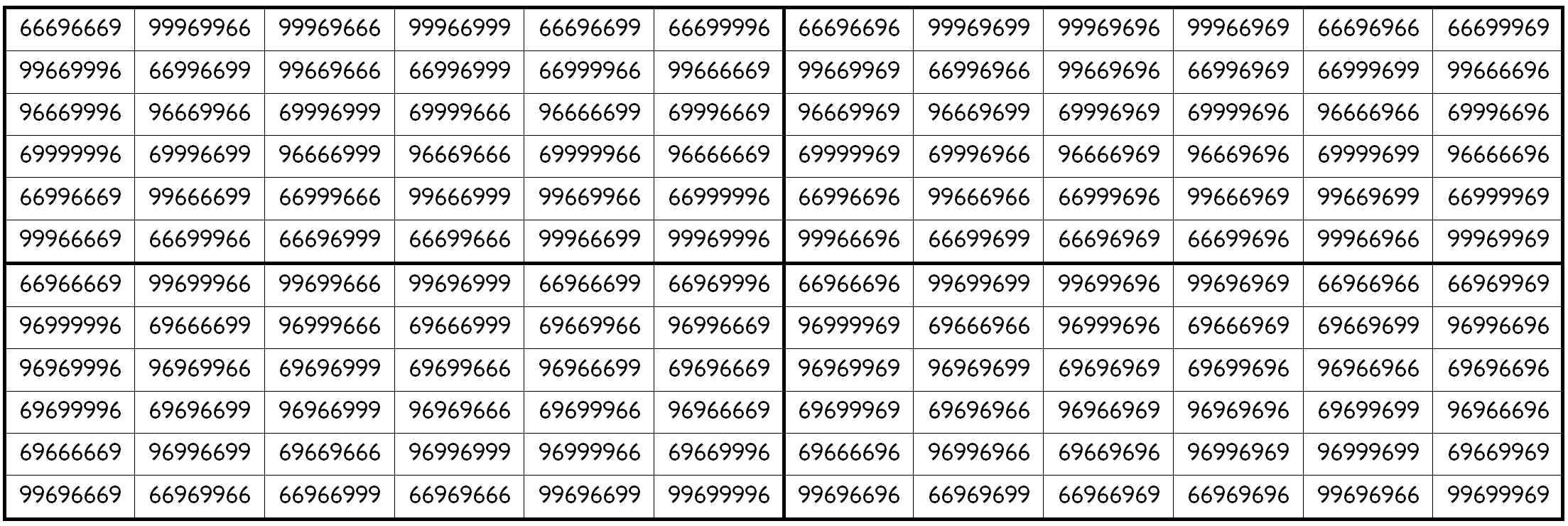
It is universal magic square with magic sum: S12×12(6,9):=999999990. Blocks of order 6 are magic square with equal magic sums: S6×6(6,9):=499999995.
Example 24. The Digits (6,9): The Blocks of Order 3
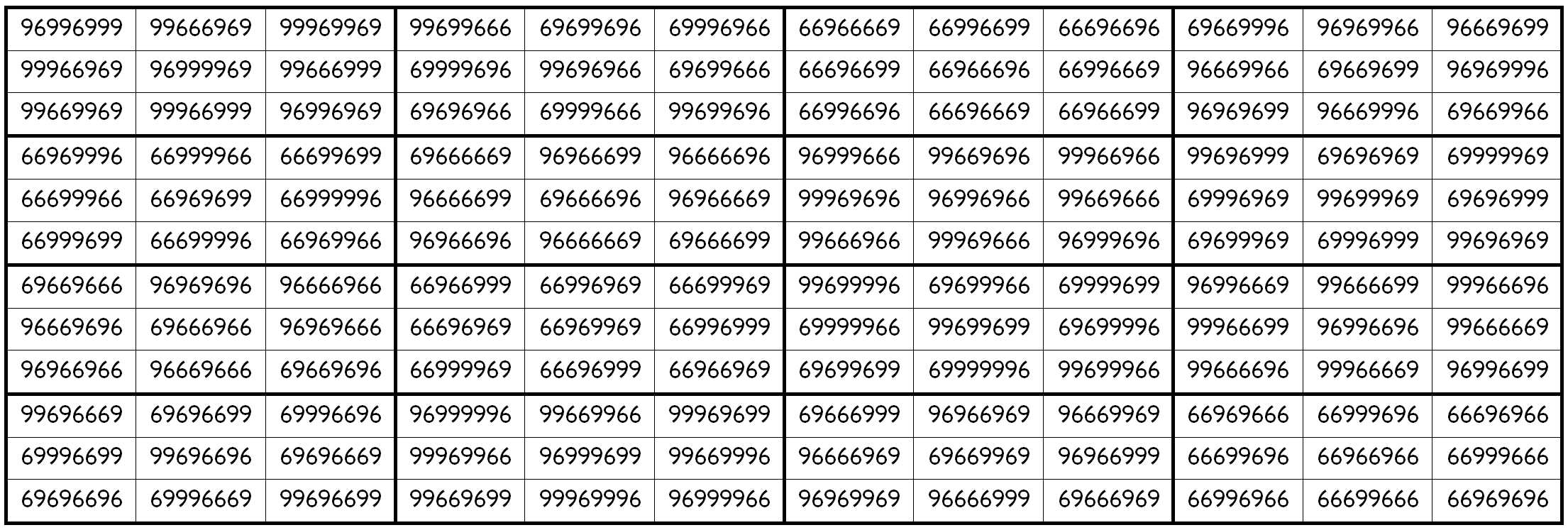
It is universal pandiagonal magic square with magic sum: S12×12(6,9):=999999990. Blocks of order 3 are semi-magic squares with different semi-magic sums.
Bimagic Squares of Order 13
a) 4-Digits Cell Entries
Example 25. The Digits (1,6,8,9)
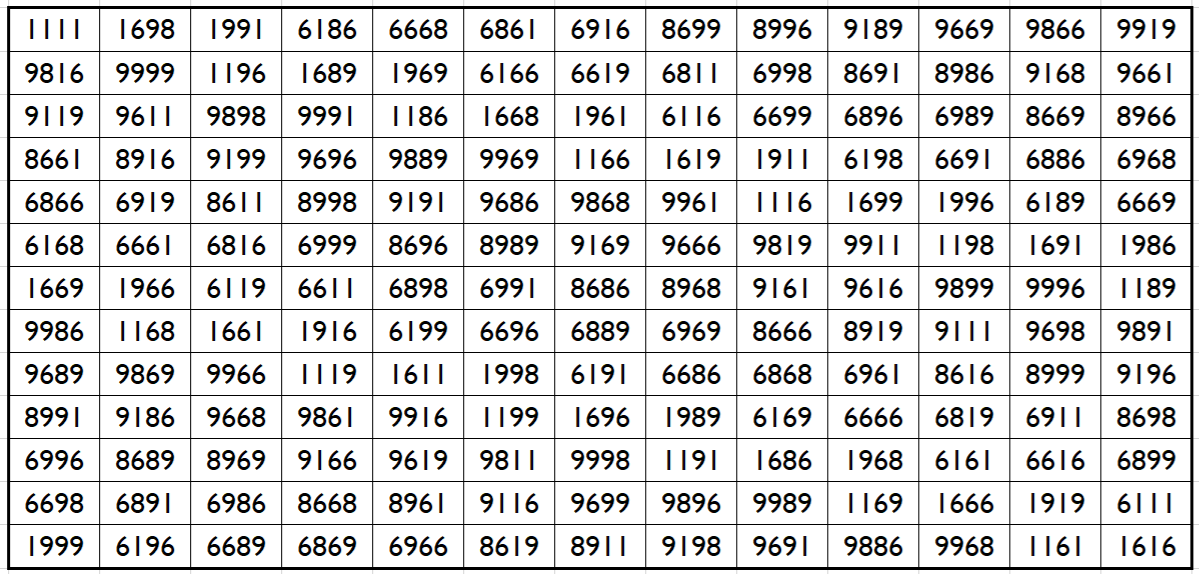
It is upside-down pandiagonal magic square of order 13 in 4-digits (1,6,8,9) with magic sum S13×13(1,6,8,9) := 87769.
Example 26. The Digits (1,2,5,8)
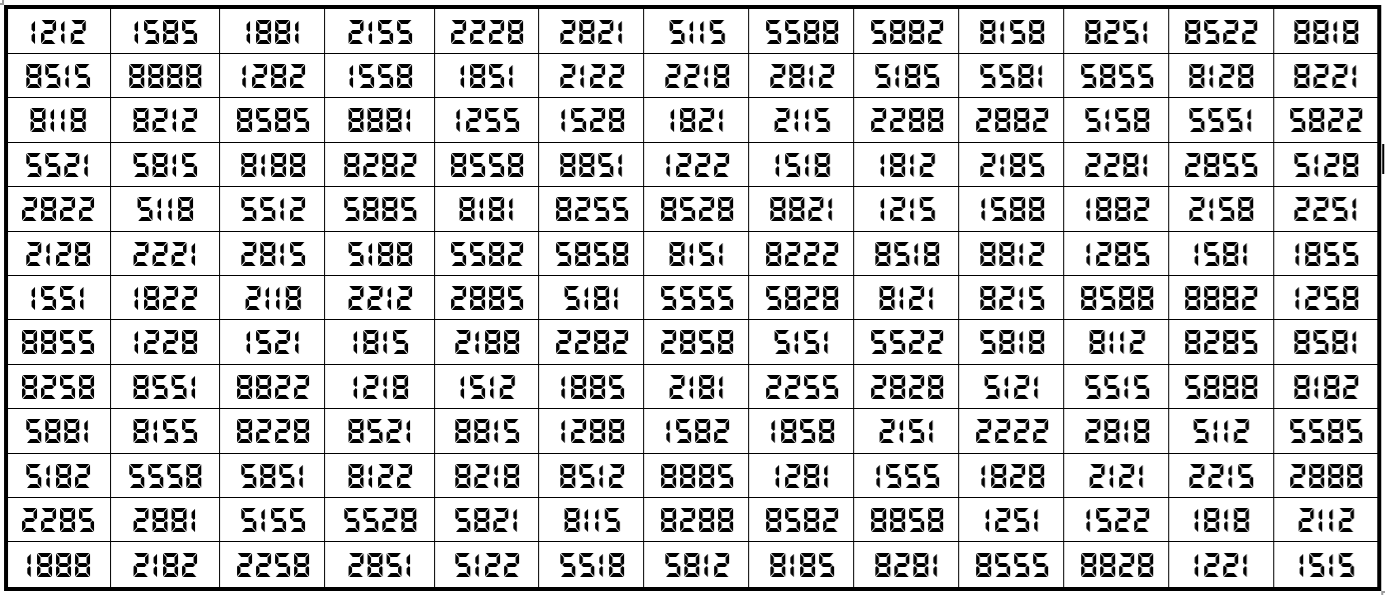
It is universal pandiagonal magic square of order 13 in 4-digits (1,2,5,8) with magic sum S13×13(1,2,5,8) := 62216.
b) 6-Digits Cell Entries
Example 27. The Digits (1,6,9)
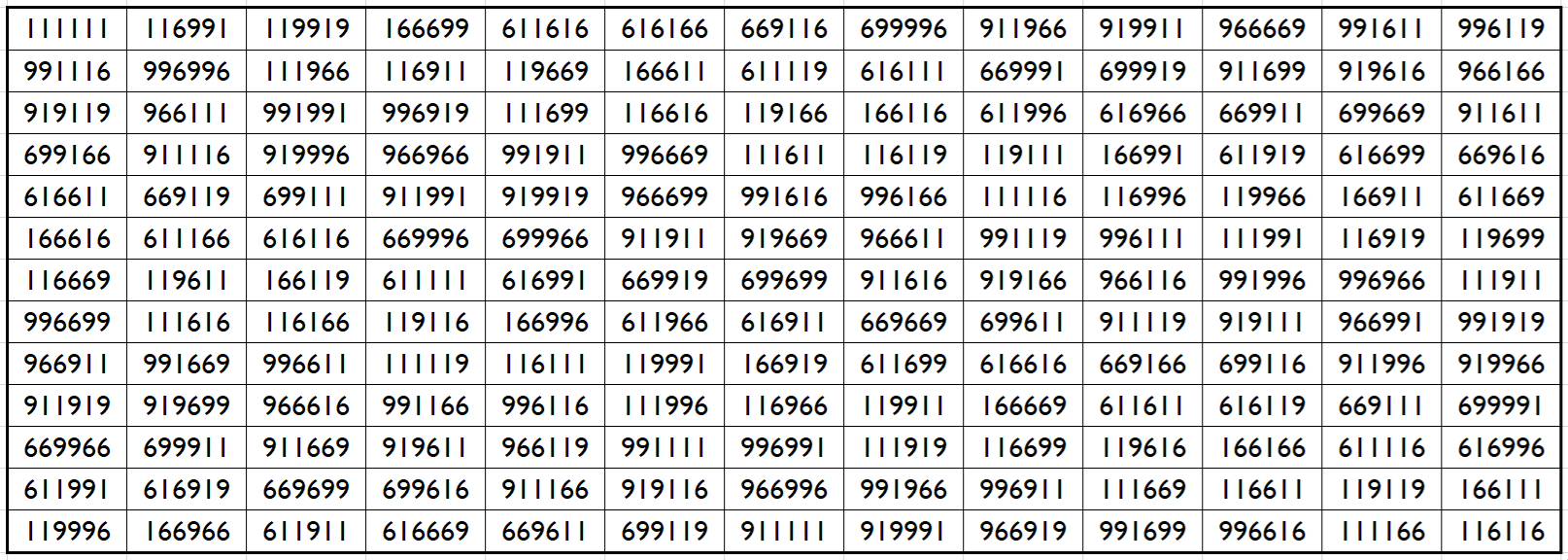
It is upside-down pandiagonal magic square of order 13 in 3-digits (1,6,9) with magic sum S13×13(1,6,9) := 7897890.
Example 28. The Digits (2,5,8)
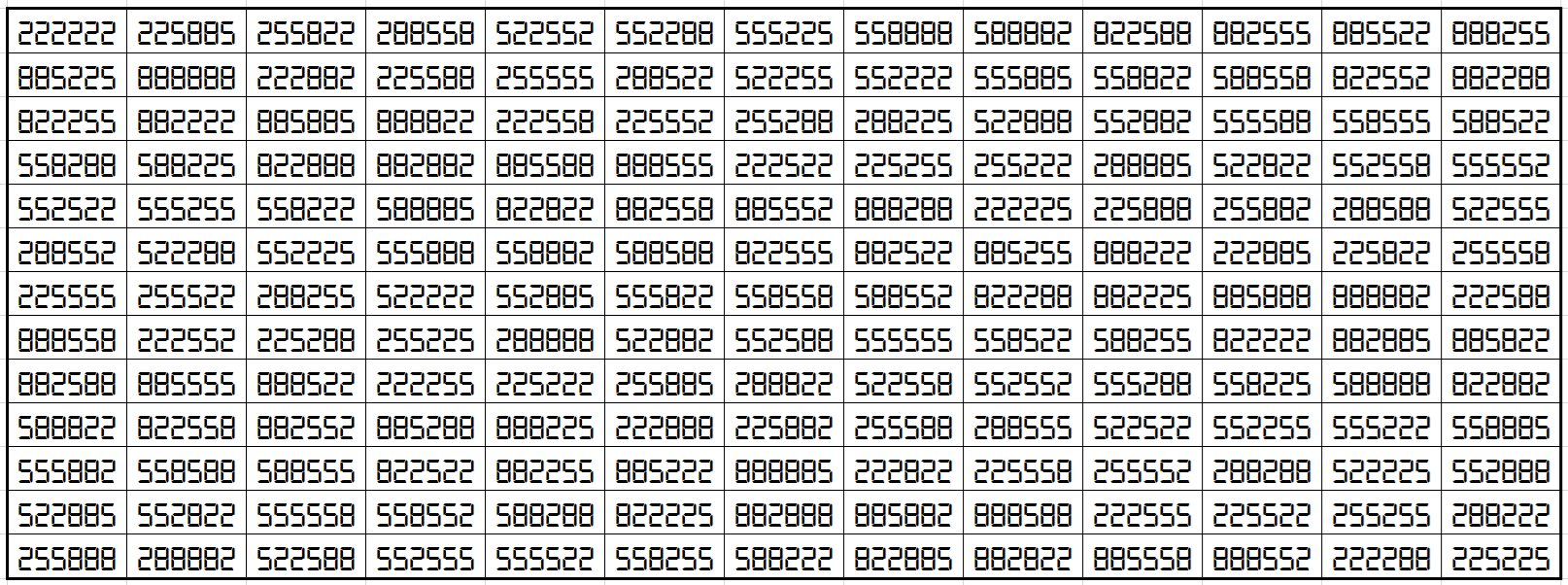
It is universal pandiagonal magic square. In this case the magic sums are different, i.e., the magic sums of original and mirror looking are the same, but in upside-down situation the sum is different. The sums are as follows:
SO13×13(2,5,8):=SM13×13(2,5,8):=7249242 and SR13×13(2,5,8):=6951945.
b) 8-Digits Cell Entries
Example 29. The Digits (1,8)

It is pandiagonal universal magic square of order 13 using only two digits (1,8) with magic sum S13×13(1,8):=688888882.
Example 30. The Digits (2,5)
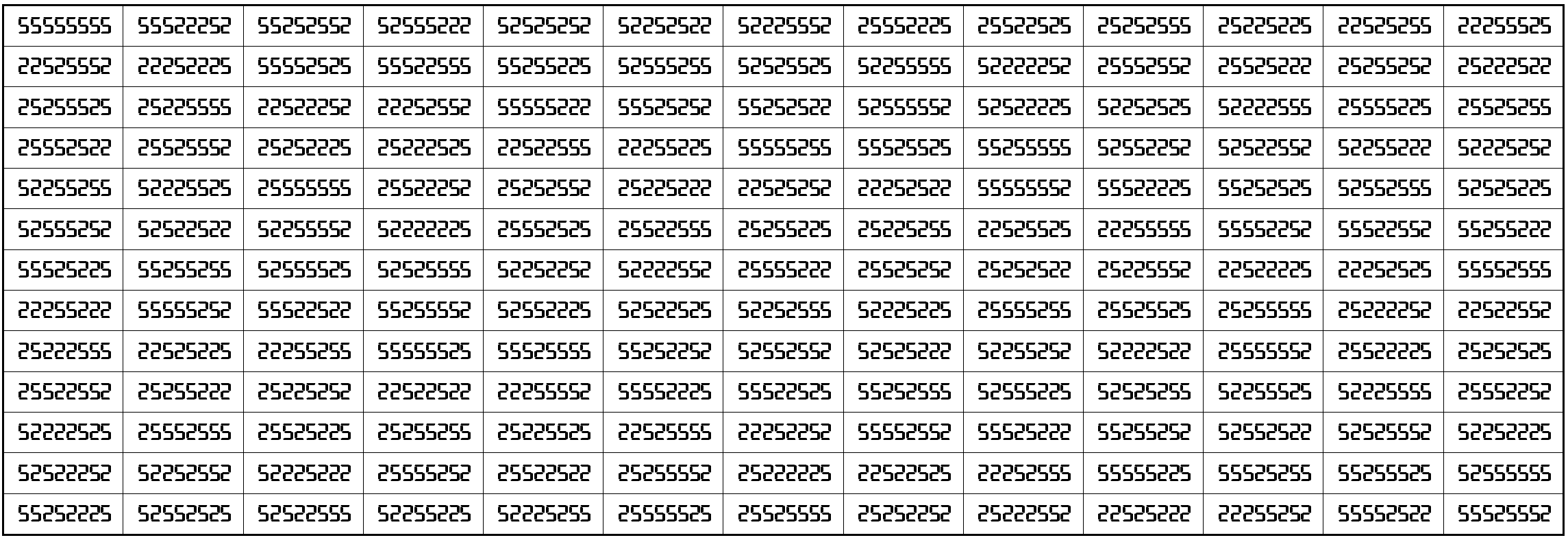
It is pandiagonal universal magic square of order 13 using only two digits (2,5) with with different magic sums, i.e., S13×13(2,5):=522222217 and S13×13(2,5):=488888884. The sum S13×13(2,5):=488888884 refers to mirror looking version.
Example 31. The Digits (6,9)

It is upside-down pandiagonal magic square of order 13 using only two digits (6,9) with magic sum S13×13(6,9):=1066996689.
Pandiagonal magic Squares of Order 14
a) 4-Digits Cell Entries:
Example 32. The Digits (1,6,8,9)

It is upside-down magic square of order 14 in 4-digits (1,6,8,9) with magic sum S14×14(1,6,8,9):= 96657.
Example 33. The Digits (0,2,5,8)
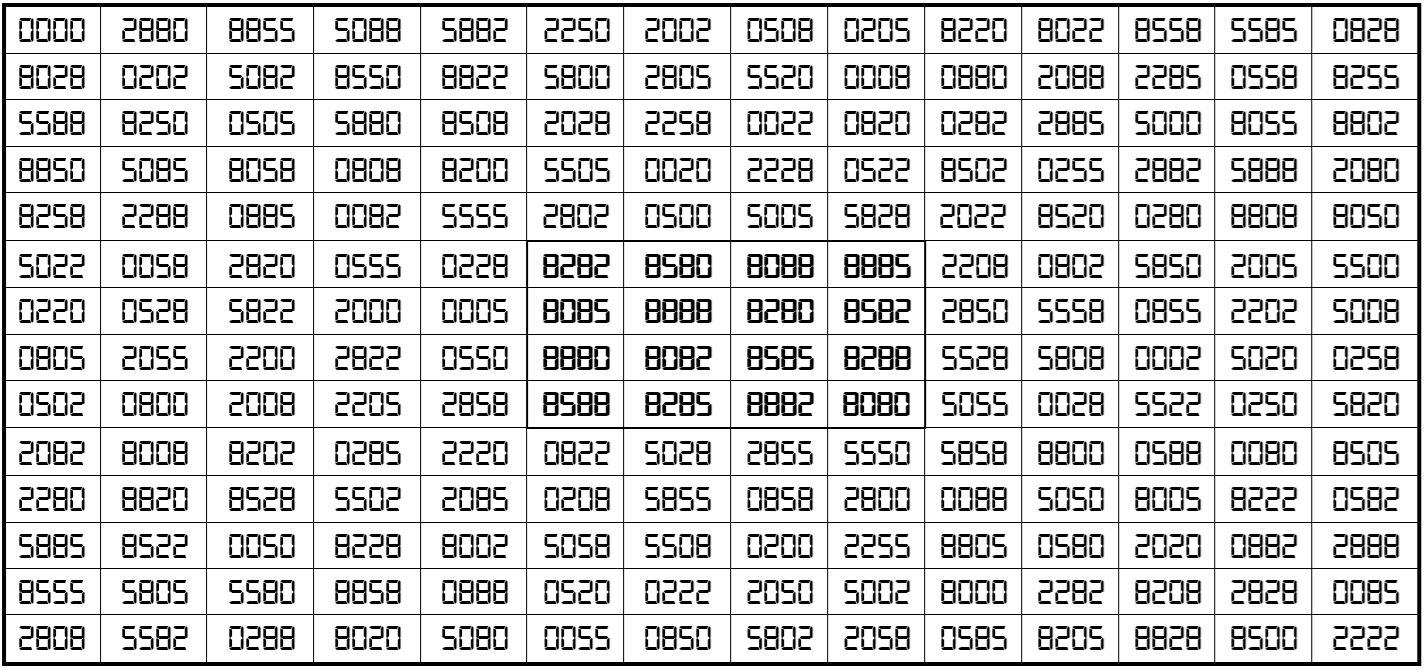
It is universal magic square of order 14 in 4-digits (0,2,5,8) with magic sum S14×14(0,2,5,8) := 58883.
b) 6-Digits Cell Entries
Example 34. The Digits (1,6,9)
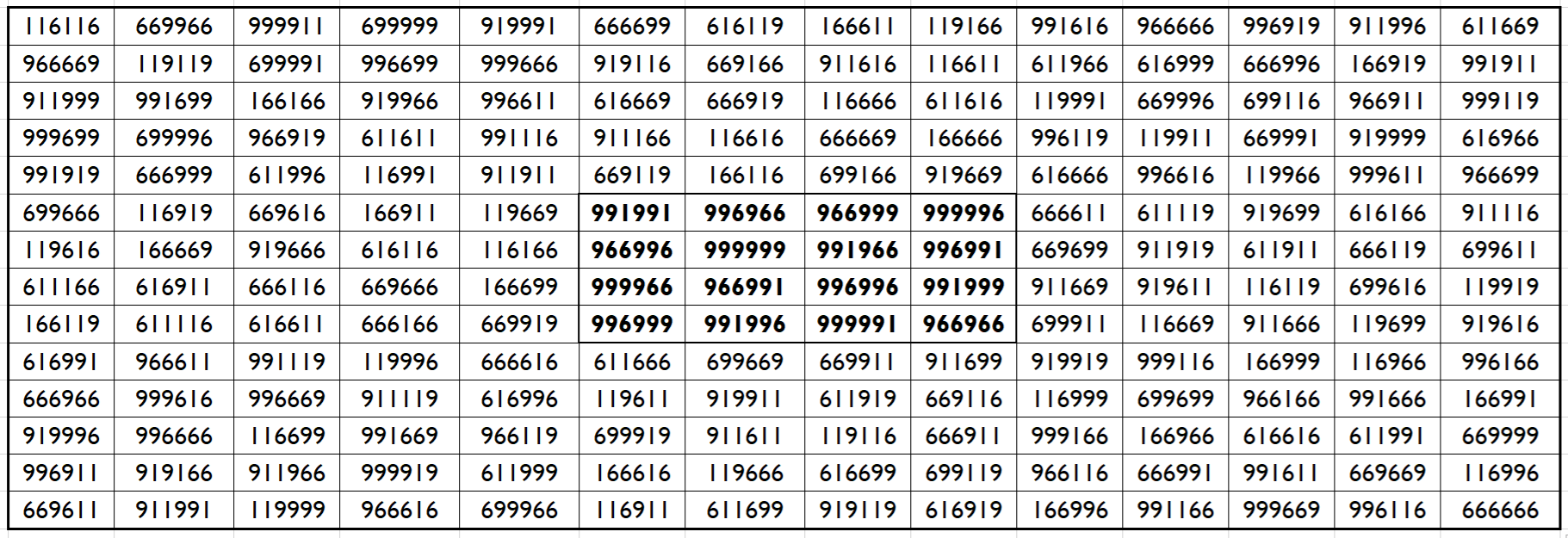
It is upside-down magic square of order 14 in 3-digits (1,6,9) with magic sum S14×14(1,6,9) := 9453444.
Example 35. The Digits (2,5,8)
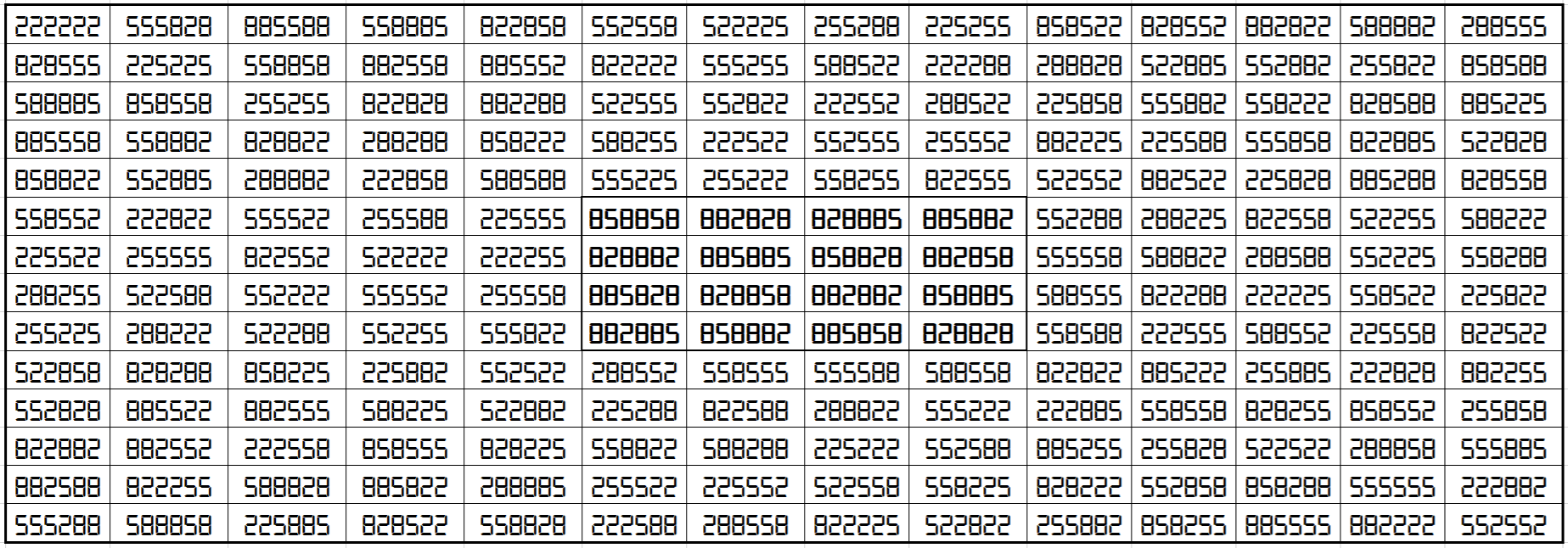
It is universal magic square of order 14 in 3-digits (2,5,8) with magic sum S14×14(2,5,8) := 8048040.
b) 8-Digits Cell Entries
Example 36. The Digits (1,8)

It is universal magic square of order 14 in 2-digits (1,8) with magic sum S14×14(1,8):=699999993.
Example 37. The Digits (2,5)

It is universal magic square of order 14 in 2-digits (1,8) with magic sum S14×14(2,5):=544444439.
Example 38. The Digits (6,9)

It is universal magic square of order 14 in 2-digits (1,8) with magic sum S14×14(1,8):=1166666655.
Magic Squares of Order 15
a) 4-Digits Cell Entries
Example 39. The Digits (1,6,8,9)
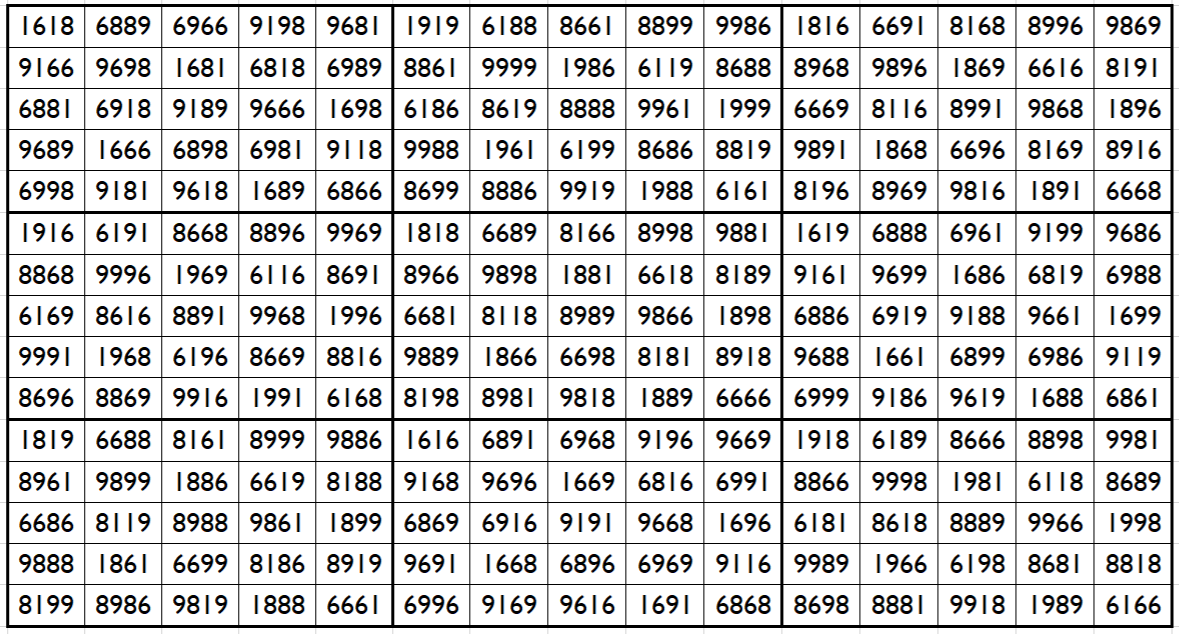
It is upside-down magic square of order 15 in 4-digits (1,6,8,9) with magic sum S15×15(1,6,8,9) := 105545. The blocks of order 5 are pandiagonal magic squares with different magic sums.
Example 40. The Digits (0,2,5,8)
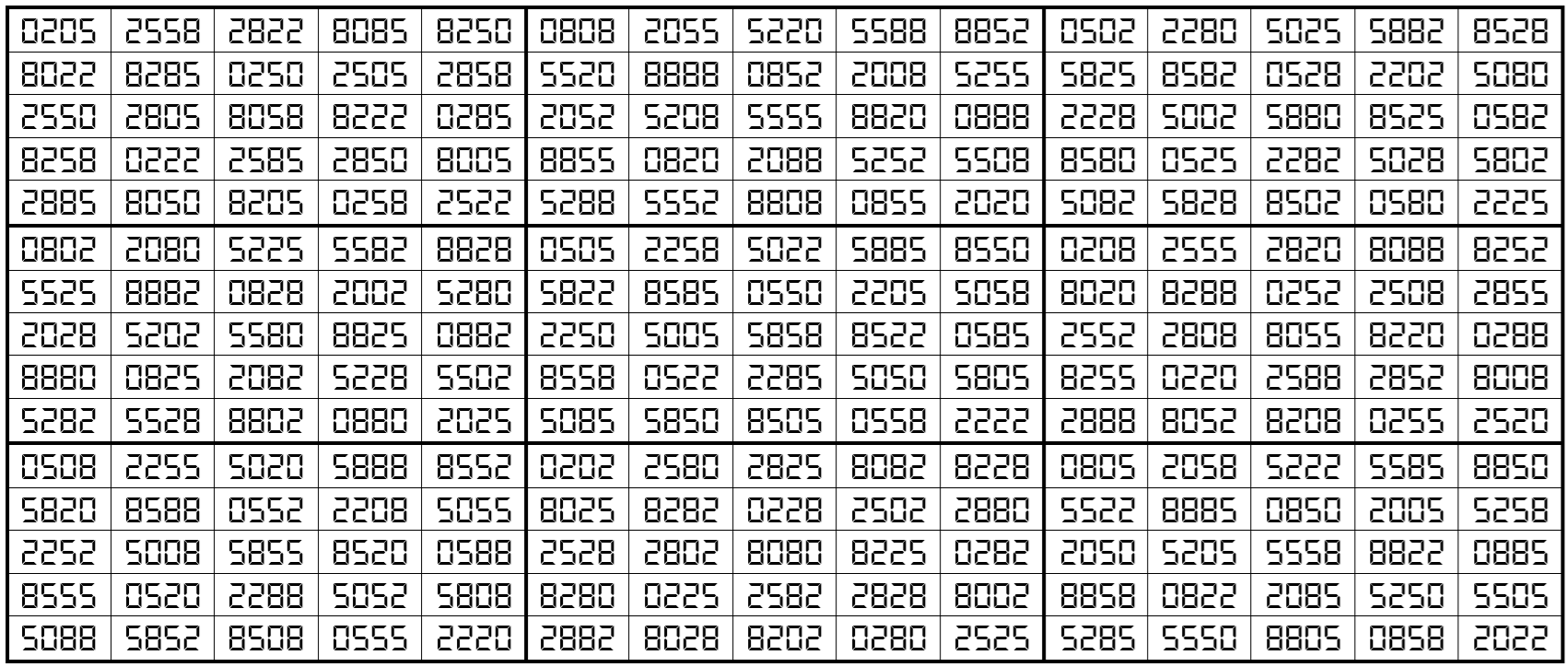
It is universal magic square of order 15 in 4-digits (0,2,5,8) with magic sum S15×15(0,2,5,8) := 66660. The blocks of order 5 are pandiagonal magic squares with different magic sums.
b) 6-Digits Cell Entries
Example 41. The Digits (1,6,9)
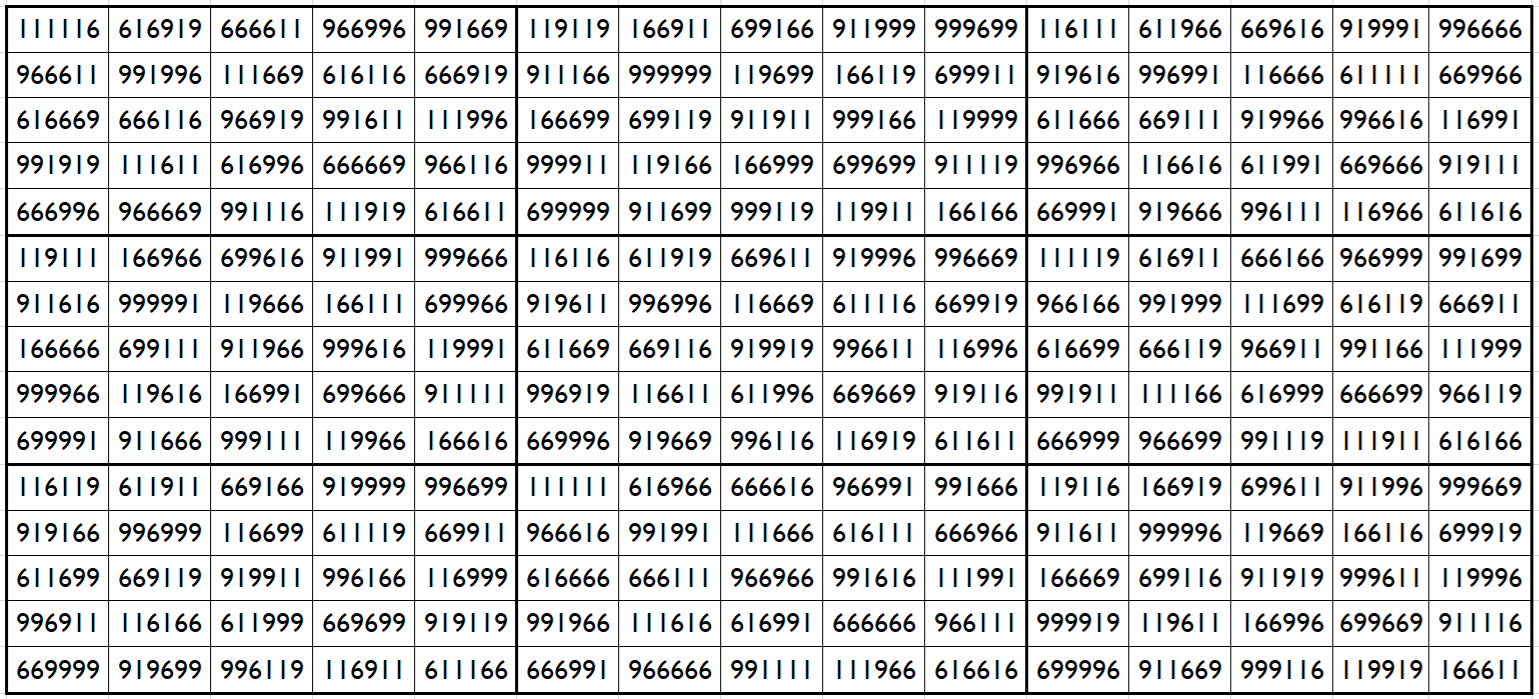
It is upside-down magic square of order 15 in 3-digits (1,6,9) with magic sum S15×15(1,6,9) := 9564555. The blocks of order 5 are pandiagonal magic squares with different magic sums
Example 42. The Digits (2,5,8)

It is universal magic square. In this case the magic sums are different, i.e., the magic sums of original and mirror looking are the same, but in upside-down situation the sum is different. The sums are as follows:
SO15×15(2,5,8):=SM15×15(2,5,8):=8936928 and SR15×15(2,5,8):=8639631.
The blocks of order 5 are pandiagonal magic squares with different magic sums.
c) 8-Digits Cell Entries
Example 43. The Digits (1,8): Blocks of Order 5

It is universal semi-magic square of order 15 for 2-digits (1,8) with semi-magic sum: S15×15(1,8):=711111104. Blocks of order 5 are pandiagonal magic squares with different magic sums.
Example 44. The Digits (1,8): Blocks of Order 3

It is universal semi-magic square of order 15 for 2-digits (1,8) with semi-magic sum: S15×15(1,8):=711111104. Blocks of order 3 are semi-magic squares with different semi-magic sums.
Example 45. The Digits (2,5): Blocks of Order 5

It is universal semi-magic square of order 15 for 2-digits (2,5) with semi-magic sums: S15×15(2,5):=566666661. and S15×15(2,5):=599999994. The magic sum S15×15(2,5):=599999994 refers to mirror-looking version. Blocks of order 5 are pandiagonal magic squares with different magic sums.
Example 46. The Digits (2,5): Blocks of Order 3

It is universal semi-magic square of order 15 for 2-digits (2,5) with semi-magic sums: S15×15(2,5):=566666661. and S15×15(2,5):=599999994. The magic sum S15×15(2,5):=599999994 refers to mirror-looking version. Blocks of order 3 are semi-magic squares with different semi-magic sums.
Example 47. The Digits (6,9): Blocks of Order 5

It is upside-down semi-magic square of order 15 for 2-digits (6,9) with semi-magic sums: S15×15(6,9):=1233336654. Blocks of order 5 are pandiagonal magic squares with different magic sums.
Example 48. The Digits (6,9): Blocks of Order 3

It is upside-down semi-magic square of order 15 for 2-digits (6,9) with semi-magic sum: S15×15(6,9):=1233336654. Blocks of order 3 are semi-magic squares with different semi-magic sums.
References
- Inder J. Taneja, Universal and Upside-Down Magic Squares of Orders 3 to 6, Zenodo, November 05, 2024, pp. 1-61, https://doi.org/10.5281/zenodo.14041149
- Inder J. Taneja, Universal and Upside-Down Magic Squares of Orders 7 to 10, Zenodo, November 05, 2024, pp. 1-120, https://doi.org/10.5281/zenodo.14041164
- Inder J. Taneja, Universal and Upside-Down Magic Squares of Orders 11 to 15, Zenodo, November 05, 2024, pp. 1-141, https://doi.org/10.5281/zenodo.14041168
- Inder J. Taneja, Universal and Upside-Down Magic Squares of Order 16, Zenodo, October 16, 2024, pp. 1-28, https://doi.org/10.5281/zenodo.13942620
- Inder J. Taneja, Universal and Upside-Down Magic Squares of Order 20, Zenodo, October 20, 2024, pp. 1-56, https://doi.org/10.5281/zenodo.13958700.
- Inder J. Taneja, Universal and Upside-Down Magic Squares of Order 21, Zenodo, October 23, 2024, pp. 1-49, https://doi.org/10.5281/zenodo.13982859
- Inder J. Taneja, Universal and Upside-Down Magic Squares of Order 24, Zenodo, October 29, 2024, pp. 1-82, https://doi.org/10.5281/zenodo.14004788
- Inder J. Taneja, Universal and Upside-Down Magic and Bimagic Squares of Order 25, Zenodo, October 30, 2024, pp. 1-53, https://doi.org/10.5281/zenodo.14014851.
